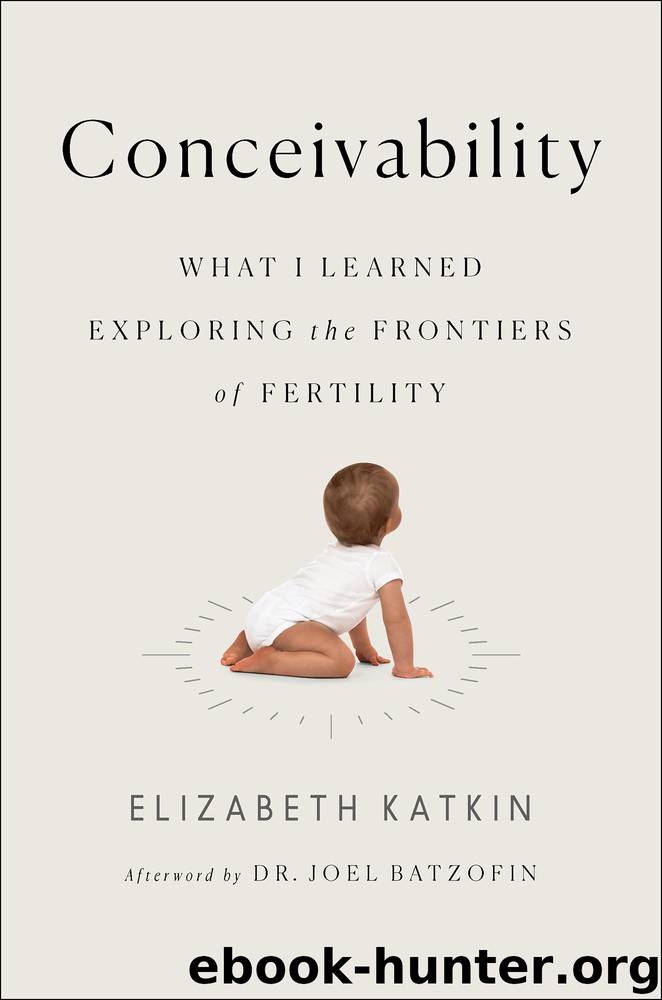Conceivability by Elizabeth Katkin

Author:Elizabeth Katkin
Language: eng
Format: epub
Publisher: Simon & Schuster
Selecting Sperm
When Claire and her partner, Daphne, decided to have a baby, they knew that their first step would be selecting a sperm bank. Comfortable with the idea of a donor, they were decidedly less at ease with what they quickly came to view as the problematic market for sperm.
They began with their fertility clinic, which was essentially chosen for them as it was the only clinic that Claire’s insurance would cover. Meeting first with the director of the well-known clinic’s in-house sperm bank, Claire and Daphne were shocked to learn that all donations were anonymous, and that the information available about the donors was limited to only one line of statistics. When Claire asked if it was possible for them to get more information in order to have a more complete profile of the potential father of their child, the director replied that that was neither possible, nor necessary: “I met them, and if I didn’t like them, I wouldn’t use their sperm.” Dejected and certain that this sperm supplier was not a good fit, Claire and Daphne discovered that they could obtain sperm elsewhere and still use it at their insurance-mandated clinic.
The market for sperm has evolved to the point that it is nearly unrecognizable from its origin, more than a century ago. In 1790, the first successful pregnancy by artificial insemination was performed under the care of renegade Scottish surgeon Dr. John Hunter, who advised an infertile couple to have the husband collect his sperm into a warm syringe and then inject it into his wife. More than ninety years later, Dr. William Pancoast, a little-known doctor in Philadelphia, helped a similarly childless married couple conceive by performing the first known successful insemination by sperm donor—unbeknownst to the wife, who had been chloroformed while Dr. Pancoast solicited the donation of sperm from his most handsome student.13
From its somewhat dubious inception in 1884 up to the 1970s, sperm donation was performed locally, using fresh sperm, for heterosexual married couples. By the 1970s, the ability to freeze sperm led to commercialization and the birth of the modern sperm bank, which was available only to married couples. The AIDS crisis in the 1980s, which pushed the banks to freeze all sperm in order to test donors for HIV, fueled the growth and scalability of the banks. By 1995, sperm had become a big business, with sperm banks in all fifty states as well as dozens of other countries capable of shipping sperm in liquid nitrogen tanks to any destination. Sperm, in fact, grew to be one of Denmark’s top exports.14 Business exploded over the next twenty-odd years as societal trends turned in its favor, with couples marrying later, or not at all; gay marriage becoming the law of the land; and lesbian couples increasingly pursuing childbirth. In 2017, the typical sperm bank transaction is a far cry from its roots—global as opposed to local, frozen as opposed to fresh, purchased primarily by single women and lesbian couples, rather than their married, heterosexual peers.
Download
This site does not store any files on its server. We only index and link to content provided by other sites. Please contact the content providers to delete copyright contents if any and email us, we'll remove relevant links or contents immediately.
Becoming by Michelle Obama(9287)
The Last Black Unicorn by Tiffany Haddish(5066)
Beartown by Fredrik Backman(4406)
Man's Search for Meaning by Viktor Frankl(3623)
The Book of Joy by Dalai Lama(3212)
In a Sunburned Country by Bill Bryson(2941)
The Choice by Edith Eva Eger(2894)
The Five People You Meet in Heaven by Mitch Albom(2834)
Full Circle by Michael Palin(2764)
The Mamba Mentality by Kobe Bryant(2665)
The Social Psychology of Inequality by Unknown(2305)
Book of Life by Deborah Harkness(2259)
The Checklist Manifesto by Atul Gawande(2199)
Less by Andrew Sean Greer(2183)
The Big Twitch by Sean Dooley(2041)
No Room for Small Dreams by Shimon Peres(1986)
A Burst of Light by Audre Lorde(1979)
No Ashes in the Fire by Darnell L Moore(1978)
Imagine Me by Tahereh Mafi(1903)
